A lot of parameters affect your electrical configuration. In RatedPower this is no exception. Would you like to know more about these parameters?
Introduction
Electrical Configuration
This section will tackle all the parameters that affect the Low Voltage configuration, from the number of modules per string all the way to the power stations.
The first step is to select the inverter. RatedPower offers both central and string inverters. You can select an inverter from our public database or opt to upload your own equipment (How to upload your own equipment) to your private database. RatedPower also permits you to select a secondary central inverter if needed.
Central Inverter
If you select a central inverter, the power station will be defined automatically by the number of central inverters inside it (and secondary inverters as well if selected). These power stations, that can be then customized in the Power Station section, will be distributed throughout the layout.
When it comes to the low voltage electrical configuration, you can select either String Box or DC Bus System in the Electrical tab, "Solar Field".
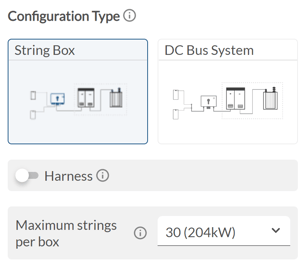
You can also specify your preferred number of strings per string box / DC bus system. This value will be used to generate a list of 30 different electrical configurations from which you need to select one.
String Inverter
Now if you opt for string inverters, the power station will be defined by the preferred and the minimum number of these inverters.
Two different low voltage electrical configurations are available for string inverters: String Inverter in Field, and String Inverter inside the Power Station.
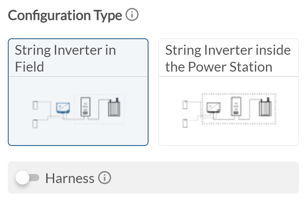
Modules per string
You have just selected the PV module and the inverter that you want, now what? RatedPower will recommend the optimal number of modules per string and set an interval of allowed values (all found in the Equipment tab, "Structure"). This interval depends on the minimum historical temperature found in the Location tab (this parameter can be modified).
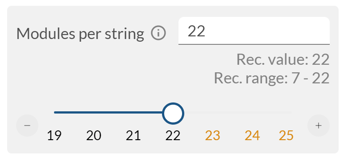
For more information on how we calculate this, please refer to our Electrical Methodology.
Customize Power Stations
When selecting the inverters of you PV plant, the software will automatically set a number of inverters by default in the main power station (PS). Accordingly, the size of the MV transformers will be calculated as the maximum power of one inverter times the number of inverters connected to each MV transformer.
As a user, you will have the possibility to define the number of inverters per Main Power Station. In addition, depending on the number of inverters per Main PS, the possibility of selecting smaller power stations (Secondary Power Stations) will be given until the minimum of 1 inverter is reached.
-png.png?width=354&height=355&name=image%20(8)-png.png)
If only the number of inverters are modified in this section, the MV transformers will be sized as stated above (Pmax inverter (kVA) * Nº of inverters connected to it).
To customize the MV transformers, and thus, Power Stations, you will also have the possibility to manually define the capacity (MVA), impedance (%) and the number of windings (2 or 3) per MV transformer, and the number of MV transformers per PS.
- Number of MV transformers per PS: this value will be limited to a maximum of two MV transformers per PS. Each MV transformer can a have a different capacity (MVA) but the impedance will be the same.
If only one inverter is included in one Power Station, the second MV transformer option will be disabled. The reason behind this is that a minimum of one inverter must be connected to one MV transformer.
-png.png?width=322&height=284&name=image%20(9)-png.png)
- Number of windings: two different options will be available regarding the number of windings per MV transformer: 2 or 3 windings. A 3 winding MV transformer will only be available if a minimum of 2 inverters are connected to it.
-png.png?width=428&height=229&name=image%20(10)-png.png)
- Capacity (MVA): As a user, you will have the possibility to manually define the capacity of each MV transformer. This value will be limited up to a 30% of the sum of the capacities of the inverters connected to that transformer.
-png.png?width=447&height=104&name=image%20(11)-png.png)
- Impedance (%): it will be also possible to manually define the value of the impedance of each MV transformer. An 8% value is set by default, but in can be modified up to a 12.5% or down to a 5% value (fixed range).
-png.png?width=450&height=151&name=image%20(12)-png.png)
DC/AC Ratio
The next input that we must define is the DC/AC ratio in the Layout tab, "Power Requirements".
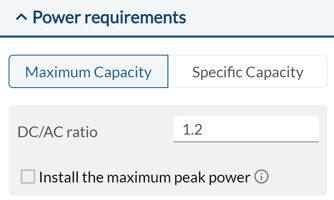
From the value indicated at this point and according to the number of strings defined for the low voltage system, RatedPower will find the electrical configuration needed to achieve this DC/AC ratio in the PV plant, installing inverters working at different DC/AC ratios if required.
Layout Configuration
To define the size of the blocks of structures that will be installed in our design, we must select one of the following alternatives in the Layout tab, "Layout Configuration":
- Regular Blocks: big blocks of structures will be installed with a shape as squared as possible. This will lead to a regular design that may not optimize the available area.
- Adaptive Design: smaller blocks of structures will be installed. Blocks of structures starting from 1x1 will be installed, fitting to the perimeter as much as possible.
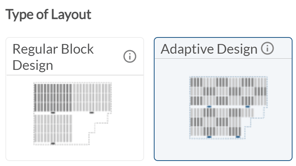
Cable sizing
In the Electrical tab, you can choose your preferred standard and RatedPower will automatically size your PV plant's cables according to the International Electrotechnical Commission (IEC) standard, the National Electrical Code (NEC) standard, the Australian standard, or the National Standard of the People's Republic of China. All these standards will apply the Maximum Rated Current (Ampacity) criterion, the Voltage Drop Limit criterion, and the Short-Circuit Temperature Rise criterion and will make sure that the cables are sized based on the most restrictive one.
Users can also define the maximum voltage drop limit for both the low voltage and the medium voltage systems.
A maximum of two cable cross-sections will be used for each subsystem to reduce the total installed cable volume.
Summary
With RatedPower, you can size your PV plant's cables following the IEC, NEC, the Australian, or the Chinese standard, choose a central or string Inverter, and define your Low and Medium Voltage systems with a reduced number of inputs, obtaining an optimized layout that will be adapted to fit your requirements.
For any other questions or more information regarding this topic, you can contact us at: support@ratedpower.com
